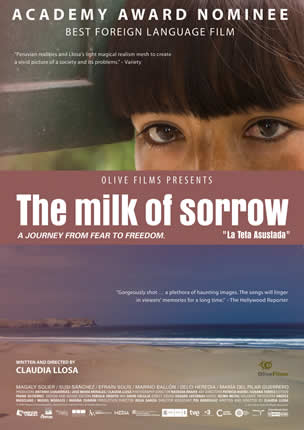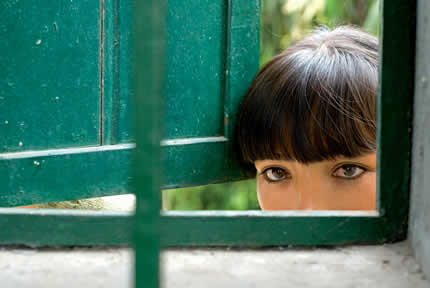 Fausta suffers from “the milk of sorrow”, an illness transmitted through mother’s milk by women who have been violated or mistreated during the war of terrorism in Peru. The war has ended, but Fausta’s life is a reminder of it because “the illness of fear” stole her soul. Now, her mother’s sudden death forces her to confront her fears and the secret that is hidden inside of her: she has inserted a potato into her vagina to serve as a protective shield that repels disgusting intruders. THE MILK OF SORROW is the story of a search for re-awakening, a journey from fear to freedom.
Fausta suffers from “the milk of sorrow”, an illness transmitted through mother’s milk by women who have been violated or mistreated during the war of terrorism in Peru. The war has ended, but Fausta’s life is a reminder of it because “the illness of fear” stole her soul. Now, her mother’s sudden death forces her to confront her fears and the secret that is hidden inside of her: she has inserted a potato into her vagina to serve as a protective shield that repels disgusting intruders. THE MILK OF SORROW is the story of a search for re-awakening, a journey from fear to freedom.
Claudia Llosa Bueno, director of The Milk of Sorrow was born November 15th 1976 in Lima, Peru. Claudia began working in advertising and television for Peruvian and foreign companies. Later on she started her own production company in Perú, Vela Films (velafilms.com.pe) and directed her first feature film, MADEINUSA (2006).
Claudia Llosa currently resides in Barcelona. THE MILK OF SORROW (La Teta Asustada) is her second feature film.
Bijan Tehrani: How did you come up with the idea of The milk Of Sorrow?
Claudia Llosa: I don’t know exactly the moment that the idea started growing in me; I guess there were so many things that made this time. At one point I was reading these books exploring women’s role in terrorism. I was trying to connect with the pain of all of these women and in one of the women’s testimonies she mentioned this syndrome called the Milk of Sorrow. I was struck by it,though I  did know much about the syndrome at the time. The idea of people communicating through their consciousness and their singing is inspiring and their belief contains so much wisdom. We see how these women talk about this illness and the burden of the war and I knew that this was something that I was going to have to study. It was also an important part of my youth, so I started writing and one of themes of the film was a song that one of the women had sung.
did know much about the syndrome at the time. The idea of people communicating through their consciousness and their singing is inspiring and their belief contains so much wisdom. We see how these women talk about this illness and the burden of the war and I knew that this was something that I was going to have to study. It was also an important part of my youth, so I started writing and one of themes of the film was a song that one of the women had sung.
BT: That song is an important element of the film and it tends to hold the film together, how did you go about using that song?
CL: I had this idea about a mother and child who had to talk to one another through singing; I tried to figure out why I had a connection to this song. There was so much that the two had to say to one another and there was only so much that they would be able to say through singing. This song creates a special relationship with the mother in that way and no one else in the family can connect to the mother through singing. At the beginning of the film the music is whispered and as the film progresses the song starts to grow and we see that this growth provides her with a sense of strength and inspiration. She actually starts reconstructing her self-esteem and the ability to sing out loud and be comfortable with whom she is. I felt that this message was something that this country needed because we are always held inside with this silent burden, but life wants you to push on in a powerful way. So this is the struggle that we go through in our world as we try to find the balance between who we were, who we are and who we are going to be.
BT: There always seems to be an element of magic in your films, can you explain this idea?
CL: A lot of people have connected my films with magic and in a way the art of surprise is the act of putting doubt into the mind of the viewer and making it difficult for them to see the difference from fantasy and reality. There is always a symbol that overtakes what the audience thinks is reality.
BT: How did you go about casting the film?
CL: With this kind of film, where it is important to show the truthfulness of the soul, it is important that I take a lot of time when it comes to casting. I usually begin the casting process at least a year before the production begins. In the end you are trying to find people that will really love the experience and have the ability to communicate through their instincts and their consciousness. I did suffer a lot with this film because even a week before we started shooting I was still looking for actors to play the most important characters in the film and luckily we found them just in time. I t was really stressful for us to work with these kind of rules. We needed to  help the actors create this love, this bond between them and the film which is very difficult to do in a short time. I am asking the actors to join us in an adventure for a couple of months and try to get the best out of the experience.
help the actors create this love, this bond between them and the film which is very difficult to do in a short time. I am asking the actors to join us in an adventure for a couple of months and try to get the best out of the experience.
BT: How did you come up with the visual style of the film?
CL: I feel that in a way I have an advantage of being a director because I can see things from many different angles. I usually work on the treatment before we start production. I wanted to film in an extreme sense with the minimum number of shots and takes because I wanted to take that risk. If I could get the scene done in two shots then I would do it in two shots; I felt that this way I would really be able to connect with my environment. I felt that I could connect with the characters better this way, and with this type of style everything fell into place and the whole team loved it.
BT: Do you have any new projects lined up?
CL: Well right now I am writing and I am fully involved in my own script but I cannot say much about it at the moment; I will have to wait until it grows and then I will know more about the story. It’s going to be a different type of film and I know that I will be able to make a very interesting story.
